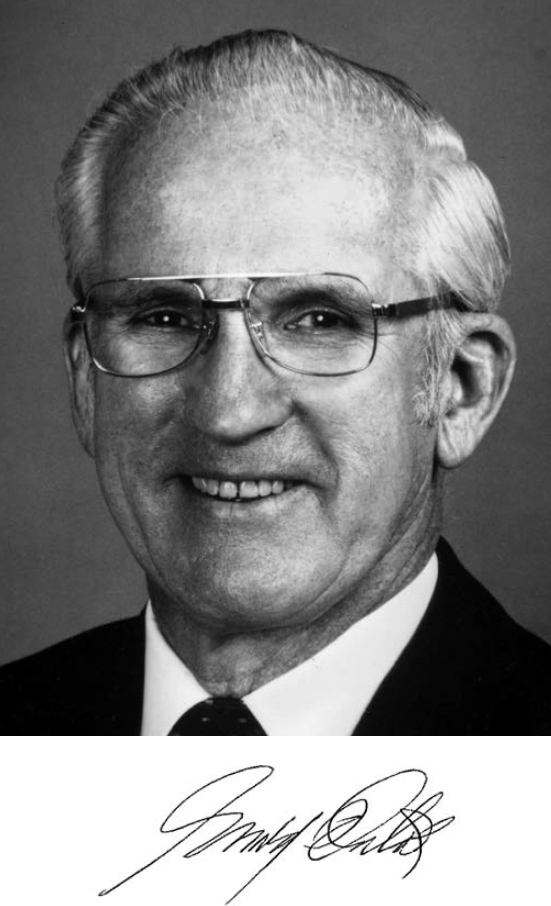GERALD T. ORLOB
1924–2013
Elected in 1992
“For fundamental contributions to the theory and practice of hydraulic, environmental, and systems engineering applied to water quality prediction and management.”
BY DANIEL P. LOUCKS AND WILLIAM W-G. YEH
GERALD THORVALD ORLOB, a pioneer in the field of water quality modeling and systems analysis in water and environmental engineering, died peacefully in his sleep in Poulsbo, Washington, at the age of 88 on March 23, 2013.
He was born July 4, 1924, to Axel and Margaret (Champlain) Orlob in Seattle, where he graduated from Shoreline High School and then served in the US Army during World War II. After the war he obtained his BS and MS degrees at the University of Washington and his PhD in hydraulic engineering from Stanford University in 1959. By this point, he already had worked as an instructor at the University of California, Berkeley, and as a survey supervisor for the Washington Pollution Control Commission, for which he conducted some of the first water quality monitoring surveys in Puget Sound.
He joined the civil and environmental engineering faculty at the University of California, Davis in 1968 and remained, as a professor and administrator, until his retirement in 1991. As coordinator of UC Davis’ cooperative education program, he established a water resources engineering program at the Catholic University in Chile. He also served as a reserve officer in the Public Health Service.
Even early in his career, Orlob was recognized as a leader, and soon became known as one of the world’s foremost authorities
in the development and application of hydrodynamic models for water quality and ecosystem management. He earned his reputation both as an academic and as the founder and head of consulting firms Water Resources Engineers, Uniconsult Inc., and Resource Management Associates.
His firms specialized in the development and application of systems analyses and mathematical modeling to water resource development and water quality control. He recruited and mentored talented engineers and scientists who applied innovative modeling technologies to the management of pollutants in the San Francisco Bay system, the Santa Ana groundwater basin in southern California, and throughout the United States and world. A few notable examples include modeling river-reservoir networks for the Tennessee Valley Authority, Australia’s Sydney Harbor, Venetian lagoon, and river basins in Poland and Romania, both of which were on the other side of the Iron Curtain at that time.
Gerald Orlob was among the first to develop the ability to simulate hydrologic, hydrodynamic, and water quality processes as they exist naturally in rivers, lakes, reservoirs, estuaries, and coastal systems, and to examine how they may be affected by human intervention. These simulation models were used to improve the management of limited or threatened water resources and to inform decision making on issues related to public health and the viability of threatened or endangered aquatic species.
The tools he developed helped to quantify consequences of alternative physical works for water storage and supply, flood control and pollution control, and effects of various management strategies. He showed how computer models that accurately simulate the behaviors of natural and managed systems could be used to study and address such issues.
He received numerous honors for his contributions to the civil and environmental engineering profession. In addition to his election to the NAE, he was a diplomate of the American Academy of Environmental Engineers and Scientists and a distinguished member of the American Society of Civil Engineers. He was awarded a Fulbright-Hayes Lectureship, and ASCE’s
Karl Emil Hilgard Hydraulic Prize, Rudolph Hering Medal, and Julian Hinds Award.
He is well known in part because of his many publications—he began publishing even before obtaining his PhD. Among the most influential is Mathematical Modeling of Water Quality: Streams, Lakes, and Reservoirs (Wiley-Interscience and International Institute for Applied Systems Analysis, 1983).
But Jerry, as he was called, is also well known because of his ability to inspire people to work together on important environmental problems and his sincere respect for, and support of, his colleagues and students. Many of us developed our own reputations in part because of what Jerry taught us or the opportunities he provided throughout our careers. His enthusiasm and joy in our work was infectious. He encouraged all of us to do our best and provided the guidance and mentoring to help us do so. His students’ high expectations of themselves—and the resulting achievements—were due in large part to his confidence in their abilities. “Jerry’s kids,” as they are called, have gone on to positively influence the profession through their work as professors, consulting engineers, or service in public agencies. And for those of us who were not his students, Jerry was a teacher’s teacher.
Jerry’s passion was for his teaching and research, and in 2002 he and his wife demonstrated their commitment to both by endowing the Gerald T. and Lillian P. Orlob Professorship in Water Resources Engineering, which annually recognizes UC Davis faculty members who are acknowledged leaders in water resources engineering.
He and Lillian enjoyed entertaining guests in the home he designed and built among the vineyards in Green Valley, California. They also traveled extensively throughout the world together, collecting works of art to display in their home.
After his retirement, Jerry maintained an active research program as professor emeritus until 2003, when he moved to Washington, where he designed his second new home and explored his artistic talents with a renewed interest in sketching. He also enjoyed backpacking and hiking in the mountains and fly fishing in various rivers.
Lillian passed away in 2002 after 26 years of marriage. Jerry had derived much of his energy from his marriage to Lillian. After her death he maintained contact with many of his former students, while devoting his time to his children—Kenneth W. Orlob, Kathleen M. Corley, Colette M. Markham, Curtis A. Orlob, and Mark G. Orlob—and grand- and great-grandchildren.







